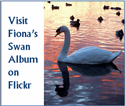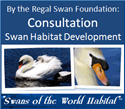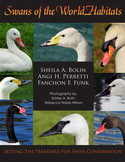Ask the Swan Specialist
Date: 4 August 2013
Hi
You need to start a petition through local residents, politicians, social media such as change.org, facebook, etc. Enough people signing the petition along with animal rights groups such as Save the Mute Swans, PETA, national and local celebrities can place pressure on the politicians to stop this culling or any other future culling. Finally, Michigan, especially Detroit is in a tenuous economic situation with Bankruptcy and the call for a boycott of any of Michigan due to wildlife management or animal culling by individuals not willing to stand by and watch or participate would be a problem for the state. Many people petitioning can get things done.
I have tried to post the following statement on the Barry News site, but it will not post due to length. Please feel free to use the statement in local media, through petitions, circulation to residents or other interested parties. I hope this helps.
The Culling of the Mute Swan in the U.S.
This reasoning to cull the Mute Swans (to repopulate Trumpeter Swans) is the most perpetuated Myth and Misalignment of Facts upon taxpayers. Pollution, natural disasters and many other causes can be linked to the loss of aquatic vegetation and habitat. This can be seen in New Zealand in which Black Swans are being culled, yet their own Wildlife Resource Department states that silt run-off actually dissipated the aquatic vegetation several years ago. Arkansas is trying to cull the swans based upon aquatic vegetation loss to ensure there waterfowl hunting season and use the case of reintroducing Trumpeter Swans (which cannot be hunted). Maryland for years, has been trying and succeeding in culling Mute Swans based upon varying studies regarding the loss of aquatic vegetation in the Chesapeake Bay blaming the swans. However, there is evidence of animal waste running off into the Bay. No one has ever tried to connect the link between this high nitrogen charged effluent and the loss of the aquatic vegetation and pollution due to the economic considerations.
ALL culling of Mute Swans and some other species in various states evolve around economic decisions, i.e., fishing, hunting or animal industries. Blame one species and do not dare blame an underlying economic reason is and has been the supposed “facts” rendered to the taxpayer. NON-BIASED studies should be undertaken prior to any culling of any species.
Mute Swans and other species which have been the brunt of culling is a world-wide problem when purist biologists and others think they know why something is disappearing, but really have no clue or do not wish to address the real cause and will blame it on the most obvious culprit, any species of animal or bird in visible sight.
Interestingly, Mute Swans were once considered protective under the Migratory Bird Act Treaty, but then in 2005, the Department of Interior changed their status and suddenly determined that the Mute Swans were non-migratory opening the door for culling the species.
In the U.S., Mute Swans are considered to be non-native species (non-migratory) although if anyone thinks that nothing can migrate during global wind patterns, etc., are not dealing with a full sense of understanding of migratory patterns. The following information was taken from Wikipedia regarding Mute Swans:
“Fossils of swan ancestors more distantly allied to the Mute Swan have been found in four U.S. states: California, Arizona, Idaho and Oregon [10] The timeline runs from the Miocene to the late Pleistocene, or 10,000 BP. The latest find was in Anza Borrego Desert, a national park in California.[10] Fossils from the Pleistocene include Cygnus paloregonus from Fossil Lake, Oregon, Froman's Ferry, Idaho, and Arizona, referred to by Howard in The Waterfowl of the World as "probably the mute type swan".[11]
1. ^ a b Jefferson, G.T. (2005). Fossil Treasures of the Anza-Borrego Desert. p. 153.
2. ^ The Waterfowl of the World. pp. 262–265.
If these studies regarding descendent fossils are true, then Mute Swans should be considered native to North America. There have also been studies indicating that the Mute Swans not solely responsible for the destruction of the aquatic vegetation relied upon by many waterfowl and other wildlife inhabiting the wetlands or other aquatic habitats. Most all of these studies seem to have been rejected by those wanting to cull the Mute Swans without substantial studies of their own repudiating these outside studies.
In some states, the solution has been to remove (cull) the mute swan (weighing 30 lbs) because it eats too much grass and is displacing the native species Trumpeter Swans (weighing 40 lbs). The theory is that a 30 lb bird is displacing a 40 lb bird. If the theory, which is readily held, that the Mute Swan is eating way too much grass, then logically thinking, how much is a 40 lb Trumpeter going to eat in that same area. Most studies point to the fact that a Mute Swan eats approximately 8 pounds of vegetation daily while a Trumpeter Swan eats approximately 20 pounds of vegetation daily.
Go to The Fact page on the Arkansas Wildlife Commission’s website regarding the Re-introduction of the Trumpeter Swan to the state of Arkansas. The following information is stated on the website:
What do trumpeter swans eat?
Adult swans eat aquatic vegetation, including the leaves, seeds and roots of many types of pond weeds. In captivity, swans will eat corn and other grains provided. Wild swans have also adapted to field feeding, eating leftover grains and vegetables that have been harvested by farmers.
Guess What? Replace the name Trumpeter Swan with the name Mute Swan and the exact same diet is eaten by the Mute Swan. So, if a 30 lb bird eating 8 pounds of vegetation daily is being killed for the destruction of aquatic vegetation and habitat, what is going to happen to that same habitat when you introduce the 40 lb Trumpeter that eats 20 pounds of vegetation daily? What happens when there is nothing left to eat for the remaining Trumpeters, or in the future there are too many of the Trumpeters and they are being accused of destroying habitats for other waterfowl? Do we now start culling them? Obviously, this will be the only way to control them and permits will be issued by state or federal wildlife entities and more money will be made for the state and federal wildlife coffers under the guise of protecting the environment.
Now, let’s look at another issue, that of a Mute Swan’s aggressiveness toward other waterfowl. Once again, let’s look at the fact sheet on the Arkansas Wildlife Commission’s website regarding Trumpeter Swans:
Will trumpeter swans run off the geese from my lake or pond?
Only a mature, mated territorial nesting pair of trumpeters will chase off (they might even kill) geese and other waterfowl in their nesting marsh. However, this aggressive behavior is usually only exhibited during the nesting season - March through October. At other times of the year, the swans will readily flock with the geese. Young swans or two swans of the same sex will not be as aggressive and generally will readily tolerate geese and other waterfowl at any time of year.
Again, let’s replace the name Trumpeter Swan with Mute Swan and the exact same natural behavior is found in the Mute Swan which is also one of the reasons that the swans are being culled, because they are territorial against geese and other waterfowl in the nesting marsh. Does this make sense? Absolutely not! We kill one species based upon its natural behaviors to replace it with another species with the exact same natural behaviors.
Again, logical thinking does not prevail, especially if a local or federal government can make money off a species. If it can be hunted, removed, etc., and a permit which someone pays to the entity can be used for revenues then the species can be culled or hunted.
Let us further consider the case of the Mute Swans which are considered non-native to the U.S. First, it is a 30-40 lb bird. Like the Trumpeter Swans, Mute Swans have necks of approximately 2 feet in length and can reach large depths. So, even turned up upside down to feed, the bird is only going to be able to reach grasses within 1-5 feet from the bank (depending on shallowness) to do too much damage. If the body of water is very shallow, then yes they can reach the grasses and even pull it from the shallows. However, if the body of water has a large drop off in depth, then the swans are only going to be able to possibly reach the tip of the grasses (if at all possible) and will not be able to pull the reeds or grasses from the pond.
Think of pulling weeds or grasses in your yard. If you grab a weed or grass by the tip, you get a handful of weed or grass, but you do not really destroy the plant because it is still rooted in the soil. Now, if you can reach down at the soil level and pull the grass or weed, then the whole or at least most of the plant is uprooted. Just as in weeds, you may or may not get the whole plant and seeds drop or parts of the plant may still be under the soil and can continue to regrow. It just takes longer to reach the size of the plant if there is a constant pulling or agitation of the plant.
This is the process with the swans. They may or may not be able to get the whole plant and/or they may or may not constantly agitate the area of the grasses and weeds. We had a situation in a swan area in which a state wanted to rebuild grasses but kept blaming the dissipation of the grasses to the swans. So, state environmental representatives placed fencing around the area of new grasses so the swans could not enter or exit due to the lack of take-off area required for flying. The grasses were not taking root and the state still wanted to blame the swans. However, when it was pointed out to them that the swans were not in the area of the fenced grasses due to the inability to get into the area, and only ducks, small wading birds, etc., were in the grasses, there was street run-off with oil, gas, grease and yard clippings, nothing was said. But, most importantly, the GRASSES WERE NOT BEING accessed by swans and they were still not growing or multiplying in the way that they should. Heaven help to blame a duck or goose, or run-off since the states make their money off of waterfowl hunting seasons or water habitat tourism!
Which now brings us to another point. Many of these areas in which grasses are being diminished and blamed on swans are actually the result of run-off from animal farms or other pollutants that are placing an enormous amount of nitrates or other chemicals in the bodies of water. There are studies that have shown that pollutant run-off can be a reason that sea or water grasses are being diminished as well as sudden silt run-off. Are there any animal farms or other chemical/silt run-offs in the Barry area such as boat oils, gasoline, sewage, etc.? A study needs to be conducted to see if these are not the primary causes before an entity can blame the problem on a specific species.
Most individuals do not know that when the Invasive Species problem became rooted in the U.S. Irresponsible animal/bird owners were accused of not caring for the animals/birds which were either intentionally or unintentionally released into natural habitats. One might ask, WHICH ENTITY let these irresponsible owners receive the permits for ownership? Of course, Fish and Game entities because once again they receive monies for these permits. Then, as the problem progressed, a new movement began to “wipe out” these invasive species and blame it on the irresponsible owner and the specific species. So, in the same category as python, boa constrictors, cane toads, etc., the following bird species have also been added: Mute Swans, Pelicans, Cormorants, Cardinals and several other species.
Why don’t we just put up a big net along each state and not allow any Migratory bird to enter the various states during migration because they might just stay? Absurd? Yes, just as the thought that Mute Swans and other swans cannot migrate into another area. We have open borders along the Bering Strait to Alaska, down through Canada and finally the West Coast of the U.S. Birds which may get caught on another migratory pattern may find themselves going into the center of Canada and then into the central U.S. and flying further south looking for natural resources.
There have any been studies showing that Mute Swans have gotten on migration paths from the U.K. to Bermuda. Bermuda is just a hop, skip and jump from the U.S. mainland and further enhances the concept that Mute Swans can naturally migrate on wind currents or migration paths during abnormal wind or weather patterns.
In Florida, we have been seeing an influx of Razor Bills, a small penguin like bird that normally does not fly south of New Jersey. Due to major hurricanes and other wind events, these birds which have been deemed as protective up north, are now found on the east and gulf coasts of Florida. Do we kill all of these protective birds because they do not belong and found a wayward path along the coasts?
We can go on and on with various examples, but I will leave you with one more to ponder. In the 60’s, poaching and DDT nearly wiped out the alligator population. There was an estimate that there was a population around 200. A concerted effort using tax payer’s money was mounted to bring the alligator back and list it as protected. Now, there is an estimate that 2.5 million alligators now reside in Florida and they are alpha predators, meaning no other predator/animal will control their population. The alligators were placed on the protective species list and now a hunting season and culling to kill nuisance alligators is used by the state. The exact disposition of the animal (killing) which was the reason to place them on the endangered species list is now the same disposition (killing) being used to control their population. Again, the state of Florida is charging a hunting permit (making money) to control the alligator. If the state of Arkansas is successful in bringing back the Trumpeter Swan at the expense of the Mute Swan and other species, how will they control their eventual overpopulation and destruction of habitat? You guessed it, an eventual culling of the Trumpeter Swan species will occur in the future with the state reaping the monetary benefits of hunting/culling permits.
It is also a known fact that some Mute Swans were brought to North America by the early colonists who stole them from the Crown. This means that some of the Mute Swan descendants came over centuries ago. So, why not leave species that have been here for centuries alone? For centuries, these species have been here and it is ludicrous to think that we are going to be able to solve the problem by culling a species to replace it with another. Time and time again, this type of wildlife management has been shown to be unsuccessful. In fact in some areas, the Trumpeter Re-introduction program has been scaled back because there have been less than stellar results.
DO NOT just blame Michigan, Maryland, New Zealand, or Arkansas for this issue as there are many other states and countries who can equally share the blame for these same illogical ideas on waterfowl/swan management.
Finally, ask yourself and conduct research, When and Where in the course of history has one species of animal/bird actually wiped out another or itself? The answer is humans which have caused the greatest habitat destruction through pollution, encroachment or poor wildlife/waterfowl management practices.
The American tax-payer needs to question and seriously take a look at the policies of their state and federal wildlife management policies to see if they are actually based on fact and are worth the monies and effort being spent in this time of budget constraints.
The following is the expressed sole opinion of Sheila Bolin
Sheila Bolin, M.S., is the CEO/President of The Regal Swan Foundation, Inc. The Foundation’s purpose is to provide humane treatment and veterinary care for swans worldwide. Ms. Bolin serves as Ask the Swan Specialist for the international swan website (www.stanley-park-swans.com) Vancouver, Canada, British Columbia
Ms. Bolin was recognized as the International Union for the Conservation of Nature’s (IUCN), Scientist of the Month in October 2010 for her swan conservation efforts. The IUCN based in Gland, Switzerland is the oldest conservation organization in the world.
Ms. Bolin has co-authored two books regarding swans Swan Keepers’ Handbook: A Guide to the Care of Captive Swans, Krieger Publishing, 2003, Malabar, Florida and Swans of the World Habitats: Setting the Standard for Swan Conservation, The Regal Swan Foundation Publishing, 2012, Orlando, Florida).
Messages In This Thread
- Plan to Kill Mute Swans in Barry County -- M -- 3 August 2013
- Re: Plan to Kill Mute Swans in Barry County -- The Regal Swan -- 4 August 2013
Ask the Swan Specialist is powered by
Tetra-WebBBS 5.30 Beta © 2006-2007 Tetra-Team






